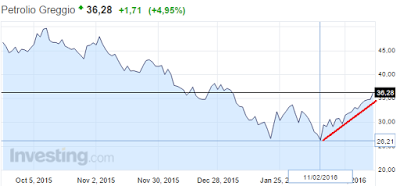
Questo favorisce un alleggerimento delle pressioni sia sul fronte delle imprese attive nello shale oil in Usa, sia sugli stati che traggono (traevano) dalle esportazioni del petrolio robuste entrate per i rispettivi bilanci.
Proprio sul fronte delle obbligazioni High Yield Energy, decisamente significativo è stato il ridimensionamento dello spread, caduto a 1500 punti da 2000 di qualche giorno fa.
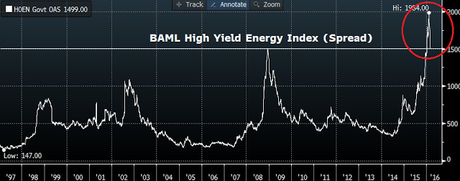
Il movimento, ovviamente, coinvolge anche altre tipologie di obbligazioni high yeld
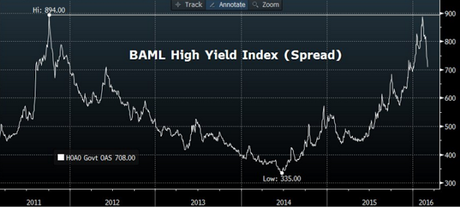
Le valute emergenti, dopo essere state tartassate (di brutto), tirano un bel sospiro di sollievo, apprezzandosi in modo significativo sia verso il dollaro che verso l'euro.
Ad esempio, il rublo russo, contro euro, è passato da 90 di metà febbraio agli 80 di oggi; mentre contro il dollaro l'apprezzamento è stato assai meno vigoroso.
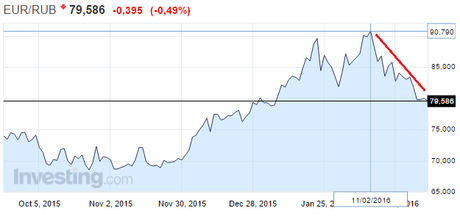
A proposito del rublo, una decina di giorni fa, sul mio profilo Facebook, avevo avvisato che valuta russa sarebbe potuta rilevarsi un'ottimo investimento, proprio grazie alla sua debolezza (in quanto è una delle valute più sottovalutate al mondo in termini reali) e per via del fatto che esistono emissioni obbligazionarie (anche di massimo rating) che offrono eccellenti tassi di interesse, idonei a compensare l'eventuale svalutazione.
Leggi il disclaimer
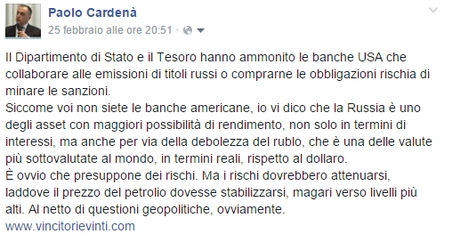
Peraltro, qualche settimana fa, avevo espresso lo stesso concetto in occasione di una mia intervista pubblicata su Investire Oggi, nella quale dicevo:
A mio parere, alcuni paesi emergenti potrebbero rivelarsi molto interessanti in un’ottica di lungo periodo. Ma sarà essenziale che si attenuino alcune pressioni e ricorrano alcuni presupposti, come ad esempio la stabilizzazione del prezzo del petrolio, magari verso livelli più alti; l’indebolimento del dollaro (o quantomeno non un rafforzamento); il miglioramento dei saldi della bilancia commerciale di alcune economie emergenti.Anche la valuta del disastrato Brasile, il real, riesce a fare molto bene, guadagnando circa il 10% contro dollaro.
Per una panoramica più esaustiva sulle valute potete guardare la tabella che segue.
Special thanks to Chalie Bilello
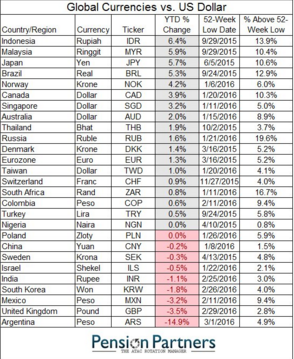
Tornando al petrolio, ieri l'Agi ha riportato la notizia secondo la quale, entro fine marzo, potrebbe tenersi un summit tra la Russia e i paesi membri dell'Opec per trovare un accordo sul congelamento della produzione ai livelli di gennaio, al fine di favorire l'aumento dei prezzi, visto che tutti i paesi (anche l'Arabia Saudita) stanno patendo (non poco) il crollo del prezzo del petrolio. Gli analisti di Bloomberg hanno anche ipotizzato che petrolio potrebbe portarsi a 50 dollari entro il prossimo giugno.
Ovviamente, ciò che dice Bloomberg, almeno al momento, lascia il tempo che trova. Ma offre comunque lo spunto per alcune considerazioni.
Infatti, se il prezzo del petrolio dovesse subire un forte rialzo, gli asset che potrebbero essere favoriti sarebbero proprio quelli legati all'oil e quindi paesi esportatori (Russia in testa) con le rispettive valute e le società dello shail oil Usa. Infatti, come abbiamo visto, la caduta degli spread sull'high yiedl Energi Usa, sembra riflettere queste aspettative.
Ma se da una parte il prezzo del petrolio più alto determinerà dei benefici a favore di talune valute emergenti, dall'altro potrebbe alleggerire le preoccupazione sul fronte della deflazione, attenuando anche le aspettative sui tassi troppo negativi da parte delle banche centrali, determinando un rialzo dei tassi delle obbligazioni e quindi la diminuzione dei prezzi. Anche se appare prematuro soffermarsi su questa eventualità (e le prossime settimane saranno importanti per capirne di più), appare comunque utile tenere in considerazione questo scenario, sopratutto qualora i prossimi dati macro dovessero apparire meno negativi rispetto a quelli usciti negli ultimi mesi.
A proposito del prezzo del petrolio, vale la pena segnalare l'analisi di Credit Suisse ripresa dal sito Value Walk
The price of oil could hit $50/bbl by May according to Credit Suisse’s global equity research analysts. In a carefully phrased research report issued to clients at the end of last week, Credit Suisse’s analysts note that oil fundamentals began to improve in February and all along the oil supply chain, signs of stress are multiplying. What’s more, it seems as if the world is not quite “heading into a recession, or worst ” so demand also remains robust. However, despite the improving fundamentals, Credit Suisse’s analysts note several times in the research note that they are not forecasting the low point of the oil cycle, or trying to bottom fish. Instead, they are merely drawing attention to the fact that there is upside risk to oil prices. Most analysts covering the oil sector believe that the global supply/demand balance will correct itself in the second half of 2016. No one expects the supply overhang to clear in the next few months, thus, there are few if any analysts forecasting that the price of oil will return to $50/bbl anytime soon. Nonetheless, the demand-side data is improving. Recent US economic data reduces the likelihood that its economy has tipped into a recession. Gasoline data for the weeklies show a strong rebound in February while the monthlies illustrate that the end-year swoon indicated by these weeklies actually did not happen. Moreover, Credit Suisse’s China research team has upgraded its outlook for the country’s economy that the risk of a “hard-landing” of that economy has reduced.
 On the supply side, Credit Suisse’s equity analysts believe that many observers mistakenly called the US onshore crude oil production machine “resilient”. True, production last year stayed stubbornly high and beat expectations. But it is also true that strong growth trends were turned around. Onshore production declined by 600kb/d from its March 2015 through to December and is expected to fall another 600kb/d this year. And as almost all of the oil producers have slashed capital spending, this year maybe one with more downside (regarding production) surprises.
On the supply side, Credit Suisse’s equity analysts believe that many observers mistakenly called the US onshore crude oil production machine “resilient”. True, production last year stayed stubbornly high and beat expectations. But it is also true that strong growth trends were turned around. Onshore production declined by 600kb/d from its March 2015 through to December and is expected to fall another 600kb/d this year. And as almost all of the oil producers have slashed capital spending, this year maybe one with more downside (regarding production) surprises.
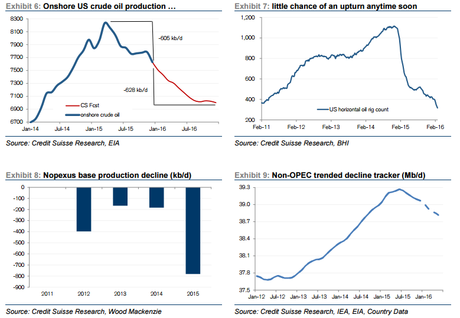 Sovereign producers are also talking which matters a great deal. The Saudis, Russians, Iraqis and Iranians may not be on the same page year, but they’ve all opened a book, and there are some signs that these production titans could be starting to come around.
Iran’s return to the market has been less explosive than many feared. Iran’s exports of crude oil have ramped by 500 kb/d up to an average of 1.5 Mb/d in February. In other words, Iran has returned to the market, and prices did not collapse.
Sovereign producers are also talking which matters a great deal. The Saudis, Russians, Iraqis and Iranians may not be on the same page year, but they’ve all opened a book, and there are some signs that these production titans could be starting to come around.
Iran’s return to the market has been less explosive than many feared. Iran’s exports of crude oil have ramped by 500 kb/d up to an average of 1.5 Mb/d in February. In other words, Iran has returned to the market, and prices did not collapse.
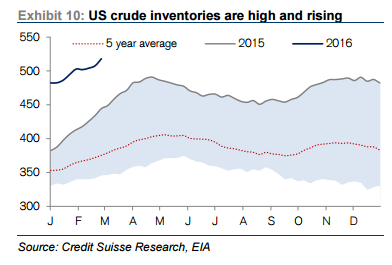 Still, despite all of the above global crude inventories remain high and global refiner maintenance is approaching its April peak, which means stocks will continue to build for at least two more months. The path to recovery will not be smooth but as Credit Suisse’s analysts write:
“We are simply drawing attention to the fact that there is upside risk to oil prices. We highlight this now because upside risk is underplayed in nearly all our conversations year-to-date; and of course because the data have become more diversified, i.e. less bearish; and the unsustainable implications of extremely low oil prices are rapidly becoming more and more clear.”
“…we don’t want to underplay downside risk; it’s just that they seem to be reducing.”
Still, despite all of the above global crude inventories remain high and global refiner maintenance is approaching its April peak, which means stocks will continue to build for at least two more months. The path to recovery will not be smooth but as Credit Suisse’s analysts write:
“We are simply drawing attention to the fact that there is upside risk to oil prices. We highlight this now because upside risk is underplayed in nearly all our conversations year-to-date; and of course because the data have become more diversified, i.e. less bearish; and the unsustainable implications of extremely low oil prices are rapidly becoming more and more clear.”
“…we don’t want to underplay downside risk; it’s just that they seem to be reducing.”

